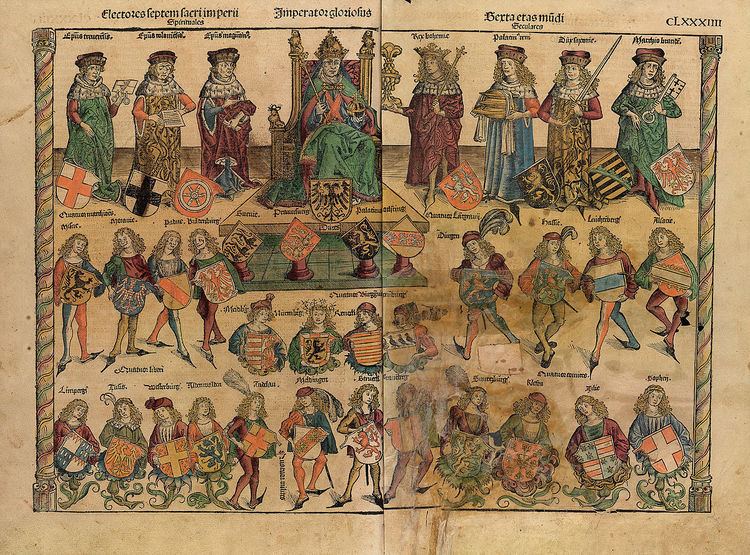 | ||
Over its long history, the Holy Roman Empire used many different heraldic forms, representing its numerous internal divisions.
Contents
Coats of arms of Holy Roman Emperors
The Reichsadler ("Imperial Eagle") was the heraldic eagle, derived from the Roman eagle standard, used by the Holy Roman Emperors and in modern coats of arms of Germany, including those of the Second German Empire (1871-1918), the Weimar Republic (1919-1933) and the "Third Reich" (Nazi Germany, 1933-1945). The same design has remained in use by the Federal Republic of Germany since 1945, but under a different name, now called Bundesadler ("Union Eagle" or "Federal Eagle", from German "Bund", genitive form "Bundes" meaning 'Union' or 'Federation', and "Adler" meaning 'Eagle').
Quaternion Eagle
One rendition of the coat of the empire was the "Quaternion Eagle" (so named after the imperial quaternions) printed by David de Negker of Augsburg, after a 1510 woodcut by Hans Burgkmair. It showed a selection of 56 shields of various Imperial States in groups of four on the feathers of a double-headed eagle supporting, in place of a shield, Christ on the Cross. The top, larger shields, are those of the seven Prince Electors, the ecclesiastical: Trier, Cologne and Mainz as well as of the titular "Prefect of Rome" on the right wing; the secular: Bohemia, Electorate of the Palatinate, Saxony and Brandenburg on the left. The depiction also appeared on the Imperial Eagle beaker
Holy Roman Emperors
From the reign of Albert II (reigned 1438–39), each Emperor bore the old Imperial arms (Or, an eagle displayed sable beaked and membered gules) with an inescutcheon of pretence of his personal family arms. This appears therefore as a black eagle with an escutcheon on his breast. Before 1438 the Emperors used separate personal and an imperial coat of arms. The arms of the High Offices of the Empire were borne as an augmentation to the office-holder's personal arms.
Other states
Listed by Imperial Circle (introduced 1500, 1512).
